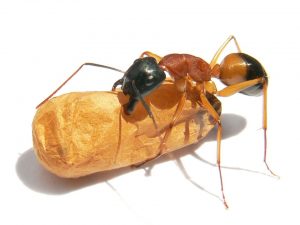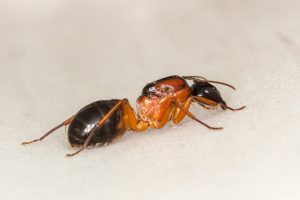What are Sugar Ants?
Also known as Camponotus Consobrinus, odorous house ants, and simply banded sugar ants, this insect gets its name because of its diet. Sugar ants collect sugar substance from flowers and plants secretion. They also collect honeydew sap from sap-sucking insects.
They are nocturnal and can be found in suburban areas. However, they also live in forests, woodlands, and grasslands. The sugar ant prefers to live in warm and humid climates and is very active during summer.

The banded sugar ant
While sugar ants prefer to consume nectar and other sweets from plants and even animals, these tiny insects might invade your home and crawl over your sweets. Usually working as a colony, they grab bits of anything sweet and take it back to their nest for their queen to feed on.
Sugar ants can easily create a huge colony that ranges between 100-10,000 ants with multiple queens.
What Do Sugar Ants Look Like?
Sugar ants are relatives of the large black ant but have distinct orange brownish bodies with black heads and mandibles. However, depending on the role they play in their colony, sugar ants can come in different sizes, shapes, and colors. In fact, their size ranges between 5 to 15 millimeters. Despite those differences, all sugar ants have 6 hardworking legs.
Worker ants are those you usually see lurking in your kitchen and usually wear a brownish orange hue. Meanwhile, the winged male soldier ants are considered royal and are a bit bigger with a black hue. The largest, of course, is the queen.
Where Do Sugar Ants Come From?
Sugar ants are widely distributed in Australia, but can mostly be found in the southeast area. In fact, it is a common household pest in Adelaide. While they are considered to be household pests, these sugar ants nest in holes in woods or roots of plants, even twigs of trees or shrubs. They are known for creating funnel-shaped small mounds or hills of less than 20 cm in diameter. Their nest consists of a vertical shaft that is approximately 15 to 17 mm in diameter, which includes chambers.
In the suburban area, sugar ants prefer to forage under house lights.
Do Sugar Ants Bite?
Sugar ants do not cause any serious medical threat and are even considered as mild-mannered ants, but when

Queen sugar ant
threatened or provoked, these tiny insects will not hesitate to retaliate. However, the bite of a sugar ant does not sting, nor is it painful. The only way it can cause a medical issue is when a person is highly allergic to the bite.
What Repels Sugar Ants
While sugar ants are considered harmless to human beings, they can be pretty annoying when they invade your kitchen cabinets in search of food. In that case, there are several ways to repel them from your home.
The most effective one is to make sure that there are no food trails or stains that they can detect. Then you need to observe carefully where they are coming from and how they enter your home. Upon observing, you have to wash away the trail with warm soapy water using a wet sponge. Doing this will confuse them and will most likely discourage them from going inside your home.
You can also repel them by placing coffee grinds near the area where they enter your home. This one works wonders because sugar ants are put off by the smell of coffee (has been said the acid in it burns them). Another natural home remedy to repel sugar ants is vinegar. Wash away the scent of their trail by wiping it with vinegar. Something you can easily find in the comforts of your home that you wouldn’t think will help deter sugar ants is a baby powder. This works as a deterrent because sugar ants could not stand the strong powdery scent. An oldie but goodie trick is by drawing chalk lines on their path.
Now, if you want to completely eradicate sugar ants without having to kill them, growing mint plants around your home will surely do the trick. You’ll be surprised how they will try to build a new colony elsewhere just to avoid the scent of mint. Now that we’ve established that strong scents are one of the main enemies of sugar ants, you’ll surely find other products in your home to repel them, some include garlic, cinnamon sticks, black or cayenne pepper, and dried bay leaves.

No Comments